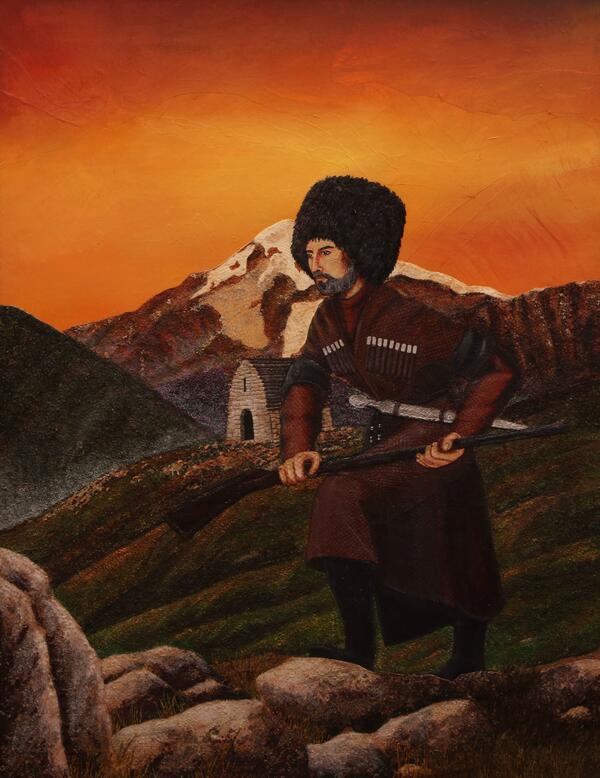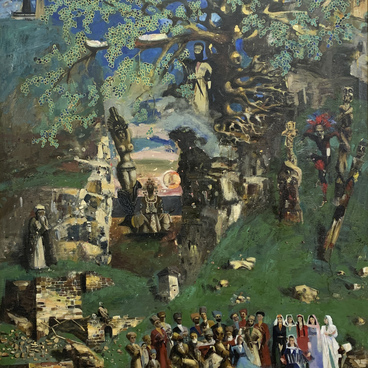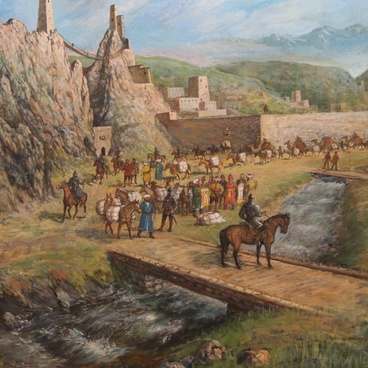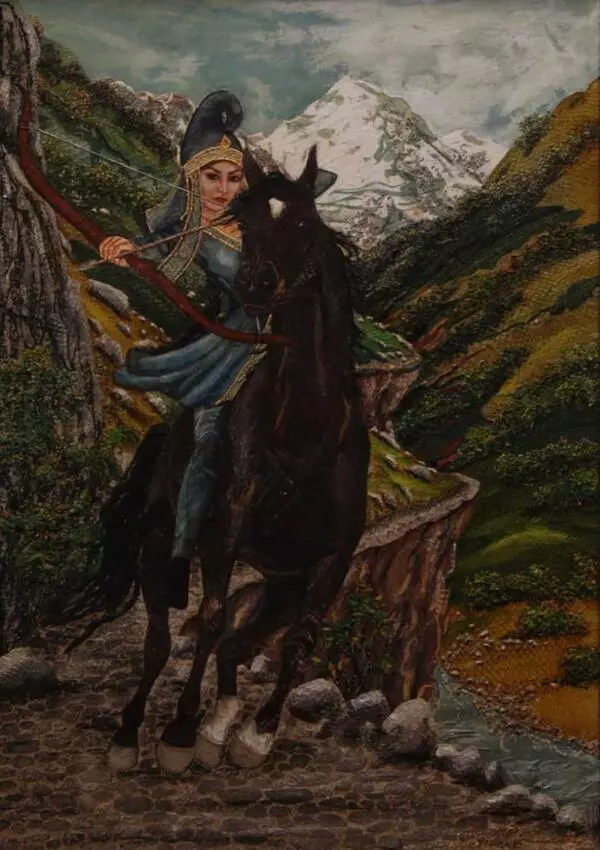Lida Ozdoeva depicted one of the sacred mountains of the Ingush people on her painting ‘Climbing Myat-loam’. This upland is called ‘The Table Mountain’ in Russian, because of its huge flat top, which resembles a table.
For centuries, the Ingush built a variety of sanctuaries on the slopes of Myat-loam. The three largest and most renowned of them were Myat-Seli, Myatar-Dyala and Susol-Dyala. People used these sanctuaries to pray for good weather or folk festivals. As a rule, in these temples people made sacrifices to the Sun — certain species of animals were chosen as the sacrifice. The believers performed such rituals up until the 1920s. The most famous of the sanctuaries is Myat-Seli, and the other two were almost destroyed, only ruins remain. Part of this sanctuary, an ancient structure with a pyramidal roof, is visible in the artwork.
There are many legends about Myat-loam in Ingush folklore. According to one legend, the mountain appeared because of the supreme god Dyala, the main deity in the ancient Ingush pantheon. Dyala created the Earth and decided to admire it from the sky. He liked everything: the mountains, the valleys and the forests. So, he said: ‘I shall put a mark on the Earth to show that the Earth is my creation’. He pressed his palm against the dry land and then raised his hand up. There was supposed to be a dent in the spot where he touched it, but something else happened: the earth, which the god had touched twice, reached for his hand. It rose high into the sky and stopped, and that is how Myat-loam was formed.
Many other Ingush legends and beliefs are connected with the mountain. According to one of them, a long time ago its was inhabited by giants. At that time, the supreme god Dyala had a precious Falcon of happiness, the ‘Irazaker’, made of silver. The mother of one of the giants wanted the Falcon for herself and commanded her son to bring her the bird.
The obedient giant was about to rob Dyala, but the omniscient god knew of his intention and immediately killed him with a lightning bolt. At that moment the giant was on Myat-loam. Dyala feared that the stench of the rotting body would spread throughout the land — so he turned his victim into a stone. It is believed that this sprawling stone giant is still visible among the outlines of the mountain to this day.
For centuries, the Ingush built a variety of sanctuaries on the slopes of Myat-loam. The three largest and most renowned of them were Myat-Seli, Myatar-Dyala and Susol-Dyala. People used these sanctuaries to pray for good weather or folk festivals. As a rule, in these temples people made sacrifices to the Sun — certain species of animals were chosen as the sacrifice. The believers performed such rituals up until the 1920s. The most famous of the sanctuaries is Myat-Seli, and the other two were almost destroyed, only ruins remain. Part of this sanctuary, an ancient structure with a pyramidal roof, is visible in the artwork.
There are many legends about Myat-loam in Ingush folklore. According to one legend, the mountain appeared because of the supreme god Dyala, the main deity in the ancient Ingush pantheon. Dyala created the Earth and decided to admire it from the sky. He liked everything: the mountains, the valleys and the forests. So, he said: ‘I shall put a mark on the Earth to show that the Earth is my creation’. He pressed his palm against the dry land and then raised his hand up. There was supposed to be a dent in the spot where he touched it, but something else happened: the earth, which the god had touched twice, reached for his hand. It rose high into the sky and stopped, and that is how Myat-loam was formed.
Many other Ingush legends and beliefs are connected with the mountain. According to one of them, a long time ago its was inhabited by giants. At that time, the supreme god Dyala had a precious Falcon of happiness, the ‘Irazaker’, made of silver. The mother of one of the giants wanted the Falcon for herself and commanded her son to bring her the bird.
The obedient giant was about to rob Dyala, but the omniscient god knew of his intention and immediately killed him with a lightning bolt. At that moment the giant was on Myat-loam. Dyala feared that the stench of the rotting body would spread throughout the land — so he turned his victim into a stone. It is believed that this sprawling stone giant is still visible among the outlines of the mountain to this day.





